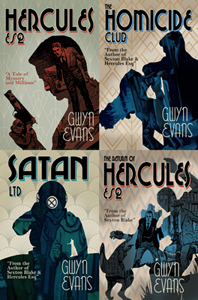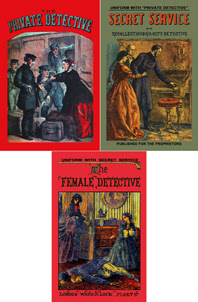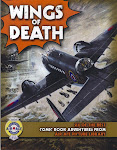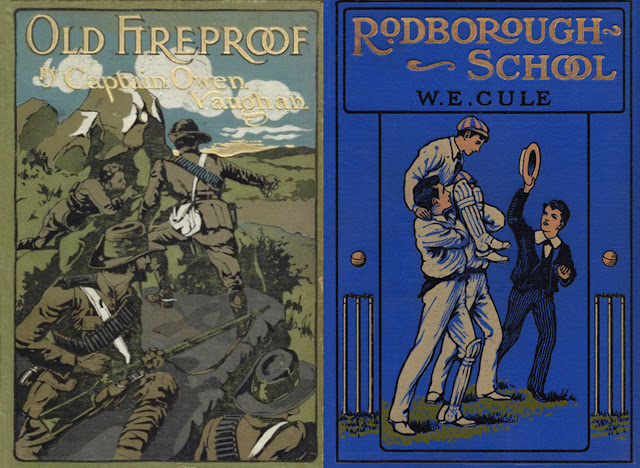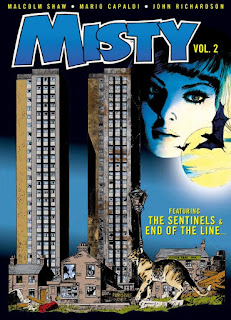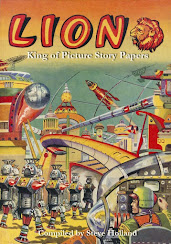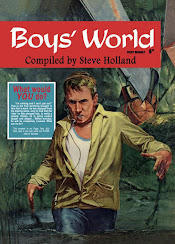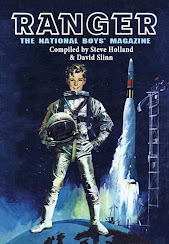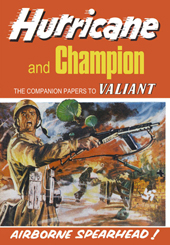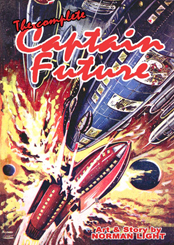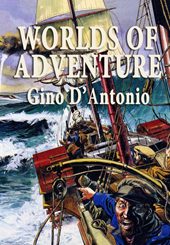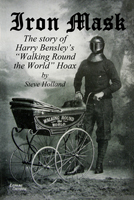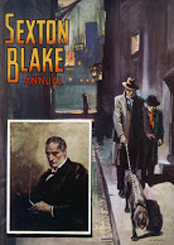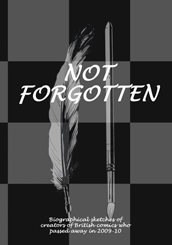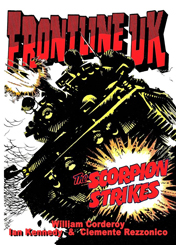Commando issues on sale 30 November 2017.
Brand new Commando issues on sale now! From the cobbled streets of old Bohemia to the perilous waters surrounding the Lesser Antilles, our Commandos can battle it out in every setting! Expect deadly French corvettes, Cossack train chases, and Nordic shipwrecks…
5075: Reclaim the Phantom
Racing through the Caribbean waters of the Lesser Antilles, Captain John Valetine was ordered to warn a British flotilla set to ambush French corvettes that they had underestimated the number of enemy vessels awaiting them. If Valentine’s 74 gunner, ‘The Phantom’, doesn’t reach the British in time then Napoleon’s forces will destroy the flotilla. But the French are the least of Valentine’s concerns as a familiar face from his past spreads poisonous words among the crew – could there be talk of mutiny?
Vincente Alcazar’s stunning artwork and attention to period detail bring Dominic Teague’s Peninsular War adventure to life, the thin line strokes of the ship’s rigging and scale of these stunning, yet mammoth vessels is a real joy to see.
Story: Dominic Teague
Art: Vicente Alcazar
Cover: Janek Matysiak
5076: Fly Fast – Hit Hard
After witnessing Flying Officer Nick Nichols shoot down one of his own men over the Libyan desert, veteran pilot Eric Wallace had him marked – but he was never able to confront Nichols on his devilish deed. After crash landing, Nick was taken to hospital then sent to England to lead a Mosquito squadron. Little did either of them know that their paths would cross once more… and that Nick would reveal his own truth regarding the murder of their fellow pilot…
With striking interior art by Amador bringing McOwan’s aerial adventure to life, Sanfeliz’s dazzling cover sets the precedence for this action heavy issue, showing a desert Hurricane pulling up post dive, leaving nothing but carnage in its wake.
Story: McOwan
Art: Amador
Cover: Sanfeliz
Originally Commando No. 408 (June 1969) Reprinted No. 1171 (November 1977)
5077: Long Way from Home
When Austria-Hungary declared war on Serbia on the 28th of July, 1914, it was only a matter of time before the rest of Europe was dragged into the Great War. But Dominik Zatopek didn’t care. He may have lived in Prague, but growing up poor he had turned to petty crime and considered himself an anarchist with no ties to any country. However, fate would have a hand to play, as Domink was thrown from side to side, never committing allegiance to any cause - that is, until he saw the passion of the Czech Legion and the notion of home suddenly because something tangible... maybe there could be a place for Domink after all?
An insight into the plight of the Czechs and Slovaks who fought in the First World War, Shane Filer’s ‘Long Way from Home’ is a tale of camaraderie that knows no national boundaries as men fight together for a common goal. Originally from Prague, Filer’s love for the city clearly shines through in Keith Page’s artwork – featuring the narrow streets and national landmarks we’ve come to associate with the city.
Story: Shane Filer
Art: Keith Page
Cover: Keith Page
5078: Viking Breed
Determined to go to sea and become a world renowned skipper, Norwegian Olaf Peterson was denied this wish after his father drowned at sea. But Olaf would never give up, even when his first boat, The Fulmar’s crew did everything in their power to make him suffer at sea – that is, until Germany invaded Norway. Then, torn from within, many Norwegians sailed to Britain to do their part for the Allies – Olaf, a stowaway was one of them – but there were some who found allegiance with the other side…
Illustrated by Australian cartoonist Peter Foster, Ian Clark’s roguish seadogs are charmingly rendered, while the harsh black and hazy lines of the sea and mist add suspense and violence to this nautical adventure.
Story: Ian Clark
Art: Peter Foster
Cover: Jeff Bevan
Originally Commando No. 2639 (February 1993)
Thursday, November 30, 2017
Wednesday, November 29, 2017
Rebellion Releases (2000AD)
Rebellion releases for 29-30 November 2017.
2000AD Prog 2059
Cover: Tiernen Trevallion
JUDGE DREDD: BLACK SNOW by Michael Carroll (w) PJ Holden (a) Quinton Winter (c) Annie Parkhouse (l)
SLÁINE: ARCHON by Pat Mills (w) Simon Davis (a) Ellie De Ville (l)
SINISTER DEXTER: BILLI NO MATES by Dan Abnett (w) Paul Marshall (a) Dylan Teague (c) Simon Bowland (l)
THARG'S 3RILLERS: THE HOUSE OF GILDED PEAK by Eddie Robson (w) Steven Austin (a) Gary Caldwell (c) Annie Parkhouse (l)
ABSALOM: TERMINAL DIAGNOSIS by Gordon Rennie (w) Tiernan Trevallion (a) Ellie De Ville (l)
The Dark Judges: The Fall of Deadworld Book 1 by Kek-W & Dave Kendall
Rebellion 978- 1781-08603-2, 30 November 2017, 166pp, £18.99 / $24.99. Available via Amazon.
Deadworld was once a planet similar to Earth, until Judge Death and his brothers Fear, Fire and Mortis deemed that as only the living could break the law, life itself should be a crime. As the Dark Judges set out to bring extinction to this parallel world, Judge Fairfax and a family of farmers attempt to escape the chaos. Is it possible for the living to evade to cold, icy grasp of Death? This chilling collection also features the Dreams of Deadworld strips, giving an extraordinary insight into the undead psyches of the internationally famous super-fiends. The never-before-collected Fall of Deadworld story-line, shining new light on internationally-beloved villains, The Dark Judges. Includes the untold origins of The Dark Judges, including Judge Dredd arch-nemesis Judge Death.
Faceache by Ken Reid
Rebellion 978-1781-08601-8, 30 November 2017, 118pp, £14.99 / $22.99. Available via Amazon.
Hilarious face-changing adventures by one of the greats of British comics! Ken Reid is consistently name-checked by the greats of comics - from Alan Moore to Kevin O'Neill, John Wagner to Pat Mills - for his unique art that is matched only by his enduring sense of humor. In a hardcover edition befitting his status as one of the all-too-forgotten greats of British comics, we present his timeless Faceache - the humorous adventures of Ricky Rubberneck, the boy with a "bendable bonce" whose skin stretches like rubber. At will, he could scrunge his face into anything, whether it's mimicking others or turning into grotesque creatures, but always coming a cropper! This is the first collection of this long lost classic from the hugely popular and long-running Buster comic.
2000AD Prog 2059
Cover: Tiernen Trevallion
JUDGE DREDD: BLACK SNOW by Michael Carroll (w) PJ Holden (a) Quinton Winter (c) Annie Parkhouse (l)
SLÁINE: ARCHON by Pat Mills (w) Simon Davis (a) Ellie De Ville (l)
SINISTER DEXTER: BILLI NO MATES by Dan Abnett (w) Paul Marshall (a) Dylan Teague (c) Simon Bowland (l)
THARG'S 3RILLERS: THE HOUSE OF GILDED PEAK by Eddie Robson (w) Steven Austin (a) Gary Caldwell (c) Annie Parkhouse (l)
ABSALOM: TERMINAL DIAGNOSIS by Gordon Rennie (w) Tiernan Trevallion (a) Ellie De Ville (l)
The Dark Judges: The Fall of Deadworld Book 1 by Kek-W & Dave Kendall
Rebellion 978- 1781-08603-2, 30 November 2017, 166pp, £18.99 / $24.99. Available via Amazon.
Deadworld was once a planet similar to Earth, until Judge Death and his brothers Fear, Fire and Mortis deemed that as only the living could break the law, life itself should be a crime. As the Dark Judges set out to bring extinction to this parallel world, Judge Fairfax and a family of farmers attempt to escape the chaos. Is it possible for the living to evade to cold, icy grasp of Death? This chilling collection also features the Dreams of Deadworld strips, giving an extraordinary insight into the undead psyches of the internationally famous super-fiends. The never-before-collected Fall of Deadworld story-line, shining new light on internationally-beloved villains, The Dark Judges. Includes the untold origins of The Dark Judges, including Judge Dredd arch-nemesis Judge Death.
Faceache by Ken Reid
Rebellion 978-1781-08601-8, 30 November 2017, 118pp, £14.99 / $22.99. Available via Amazon.
Hilarious face-changing adventures by one of the greats of British comics! Ken Reid is consistently name-checked by the greats of comics - from Alan Moore to Kevin O'Neill, John Wagner to Pat Mills - for his unique art that is matched only by his enduring sense of humor. In a hardcover edition befitting his status as one of the all-too-forgotten greats of British comics, we present his timeless Faceache - the humorous adventures of Ricky Rubberneck, the boy with a "bendable bonce" whose skin stretches like rubber. At will, he could scrunge his face into anything, whether it's mimicking others or turning into grotesque creatures, but always coming a cropper! This is the first collection of this long lost classic from the hugely popular and long-running Buster comic.
Sunday, November 26, 2017
Arthur H Buckland
ARTHUR H. BUCKLAND
by
Robert J. Kirkpatrick
Arthur H. Buckland (sometimes referred to as A.H. Buckland) was another artist who was both a highly-regarded painter of landscapes, portraits and genre pictures and an illustrator, particularly noted for his black and white plates for a number of new editions of classic novels.
He was born on 22 June 1870 in Taunton, Somerset, and christened Arthur Herbert Buckland. His father, Joseph (1844-1895) was an ironmonger; his mother, Helen (née Hadduck, 1837-1908) was the daughter of a grocer. Arthur was the second of four children – two of his brothers, Charles (born in 1868) and Frank (born in 1874) followed their father in the family business. The third brother, John (born in 1871) joined the Post Office. The family lived for many years at 4 East Street, Taunton.
Arthur received his artistic training at the Taunton School of Art, receiving a silver medal in 1888 for being the year’s best student. After leaving Taunton in around 1890, he spent three years or so at the Academie Julian in Paris (a private art school founded in 1867). He returned to England, and then, in June 1897, he travelled to America, where he married Louisa Almira Abrey (born on 9 June 1873 in Toronto, Ontario, Canada, the daughter of a merchant), at the Church of the Transfiguration in Manhattan, New York, on 10 September 1897. Arthur then brought his wife to England, settling at 3 St. John’s Wood Studios, Hampstead, re-marrying Louisa at the Marylebone Registry Office on 14 January 1898. They subsequently moved to 86 Adelaide Road, Hampstead, where, in 1901, Buckland was sufficiently well-off to be able afford a domestic servant, a cook and a housemaid.
In the meantime, Buckland had begun his career as a professional artist. He exhibited with Royal Society of British Artists in 1894, and in 1895 he began a long association as an illustrator with The Pall Mall Magazine (an offshoot of The Pall Mall Gazette, which had been launched in 1893). Two years later, he exhibited at the Royal Academy, and went on to exhibit at the Fine Art Society, the Royal Institute of Painters in Watercolours, and the Royal Institute of Oil Painters.
In 1897 he began a long association with the publisher Methuen & Co., for example illustrating most of its “Little Blue Books for Children” series (such as The Beechnut Book by Jacob Abbott, A School Year by Netta Syrett, and The Lost Ball by Thomas Cobb). In 1900, he also began working with Collins, for whom he illustrated re-issues of novels by authors such as Charles Dickens and the Brontë sisters. He also illustrated a few books for Blackie & Son, including two school stories by Angela Brazil and Lilian F. Wevill, and Blackie’s Children’s Annual.
In 1901 he began another long relationship with The Illustrated London News, which published his work until at least 1926. Other magazines and periodicals to which he contributed were Cassell’s Magazine, The Sphere, Pearson’s Magazine, The Graphic, The Sketch, The Windsor Magazine, The Art Journal, The Artist, The Christian Realm and The Bystander.
On 6 November 1906 he filed for a divorce on the grounds that his wife was incapable of consummating their marriage. By then, the couple had separated, with Buckland remaining at 86 Adelaide Road and his wife living at 23 Milford Road, Leytonstone. The marriage was formally ended on 18 November 1907.
Buckland subsequently appears to have suffered a slight downturn in his fortunes, as he appears in the 1911 census living in a boarding house at 13 Lady Somerset Road, St. Pancras. He was still working as an artist, although while his last credited book illustrations appeared in 1912, he continued to supply illustrations for magazines.
In 1912 he married Marian Ethel Richardson (born in 1875 in Crewe, Cheshire, the daughter of a commercial clerk, and who had once worked as an artist’s model), in Barnet, where the couple lived for over 25 years. They had one child, Audrey Helen, born on 22 November 1914.
It is not known what, if anything, Buckland did during the First World War. His name does not seem to appear in any newspaper advertisements for magazines or periodicals until 1926, for work in The Illustrated London News and The Sketch. In 1939, he moved back to Taunton, where he lived for a while Marian and his brother Joseph (then retired) and his wife in Ashbury South Road. He was still working as an artist, with his daughter working as a masseuse. Within a year or two he had moved to Lyme Regis, where he lived at Pyne House, Broad Street; 5 Cobb Terrace; and finally at “Kincora”, West Hill, where he died on 22 December 1948, leaving an estate valued at £7,633 (around £280,000 in today’s terms). His wife died at the same address six years later, leaving an estate worth just £341.
PUBLICATIONS
Books illustrated by A.H. Buckland
The Channings by Mrs Henry Wood, Richard Bentley, 1897 (re-issue)
The History of Henry Esmond, Esq. by W.M. Thackeray, Methuen & Co., 1899 (re-issue)
Mrs Halliburton’s Troubles by Mrs Henry Wood, Collins, 1900 (re-issue)
The Channings by Mrs Henry Wood, Collins, 1900 (re-issue)
A Gallant Quaker by Margaret H. Robertson, Methuen & Co., 1900
The Air-Gun, or How the Mastermans and Dobson Major Nearly Lost Their Holiday by T. Hilbert, Methuen & Co., 1901
The Beechnut Book by Jacob Abbott, Methuen & Co., 1901
The Castaways of Meadow Bank by Thomas Cobb, Methuen & Co., 1901
The Wouldbegoods by E. Nesbit, T. Fisher Unwin, 1901
Jair the Apostate by A.G. Hales, Methuen & Co., 1902
The Inca’s Treasure by Ernest Glanville, Methuen & Co., 1902 (re-issue)
A School Year by Netta Syrett, Methuen & Co., 1902
The Treasure of Princegate Priory by Thomas Cobb, Methuen & Co., 1902
The Peeles at the Capital by Roger Ashton, Methuen & Co., 1902
The Lost Ball by Thomas Cobb, Methuen & Co., 1903
Mrs Barberry’s General Shop by Roger Aswhton, Methuen & Co., 1903
The Quest of the Luck by Lewis Ramsden, Collins, 1904
The Virgin and the Scales by Constance Cotterell, Methuen & Co., 1905
The Castle of the Shadows by Mrs C.N. Williamson, Methuen & Co., 1905
The Dryad by Justin Huntly M’Carthy, Methuen & Co., 1905
The Weans at Rowallan by Miss K. Fitzpatrick, Methuen & Co., 1905
The Valley of the Shadow by William Le Queux, Methuen & Co., 1905
Mr Galer’s Business by William Pett Ridge, Methuen & Co., 1905 (re-issue)
The Fortunes of Philippa by Angela Brazil, Blackie & Son, 1906
Little Susy Stories by E. Prentiss, Collins, 1906
The Lost Explorers: A Story of the Trackless Desert by Alexander Macdonald, Blackie & Son, 1907
Betty’s First Term by Lilian F. Wevill, Blackie & Son, 1907
The Botor Chaperon by C.N. & A.M. Williamson, Methuen & Co., 1907
Tales of Two People by Anthony Hope, Methuen & Co., 1907 (re-issue)
Flower o’ the Orange, and Other Stories by Agnes and Egerton Castle, Methuen & Co., 1908
Anne’s Terrible Good Nature, and Other Stories for Children by E.V. Lucas, Chatto & Windus, 1908
The Great Miss Driver by Anthony Hope, Methuen & Co., 1908
The Scarlet Runner by C.N. & A.M. Williamson, Methuen & Co., 1908
The Emperor of the Air by George Glendon, Methuen & Co., 1910
Cross and Dagger: The Crusade of the Children, 1212 by W. Scott Durrant, Methuen & Co., 1910
The Master Girl by Ashton Hilliers, Methuen & Co., 1910
The Golden Silence by C.N. & A.M. Williamson, Methuen & Co., 1911
Fire in Stubble by Baroness Orczy, Methuen & Co., 1912
Nicolette: A Tale of Old Provence by Baroness Orczy, Methuen & Co., 1912
The Guests of Hercules by C.N. & A.M. Williamson, Methuen & Co., 1912
Re-issues of famous novels, all published by Collins – dates not known
Agnes Grey by Anne Brontë
Scenes of Clerical Life by George Eliot
Waverley, or ‘Tis Sixty Years Since by Walter Scott
Wuthering Heights by Emily Brontë
Vilette by Charlotte Brontë
Reprinted Pieces by Charles Dickens
Martin Chuzzlewit by Charles Dickens
The Old Curiosity Shop by Charles Dickens
Barnaby Rudge by Charles Dickens
Stepping Heavenward by Mrs Prentiss
Old Jack by W.H.G. Kingston
Friday, November 24, 2017
Comic Cuts - 24 November 2017
I'm back on track with the Fifty Forgotten Authors book, with another essay in the bag. Not the one I intended to write, but another interesting one, nonetheless, which was prompted by a question from someone who stumbled onto Bear Alley in search of some information. His enquiry sent me on a day-long dig for information, at which point I thought I had enough to make an interesting essay on the author. Next week I'll try to get back to the piece I was actually planning to work on, which I started writing three weeks ago!
The new essay brings our total to 24 essays and 104,096 words. The cover for the first ebook is nearly done, but I'll wait until next week to post it here.
I was doing the research with a certain amount of trepidation. Odd as it may sound, doing research can take you into one or two dark corners of the internet and I've always been a big fan of No Script, which blocks a lot of unwanted javascript and flash. On a practical level, it also saves me a lot of hanging around waiting for my elderly computer to catch up, as I'm not wasting bandwidth on pop-up windows, promos and auto-playing videos, or putting my computer at risk from malware disguised as advertising.
Firefox, my favoured browser, had a major update last Tuesday and it knocked out the version of No Script I used. So I cautiously kept going while we were waiting for the guy who created No Script (yes, it's just one guy) to catch up, which he promised to do by Sunday. To cut a long story short, I picked up a bit of a bug.
Thankfully, it was easily isolated and removed by Windows Defender. However, just to be on the safe side, I ran a full scan on the computer that took almost 24 hours to run and discovered that there were a couple of other low-level bugs on the system. Again, they were isolated and removed. But it just goes to show that, whether you're being careful or not, it's easy to pick these things up without knowing it and I don't think it's out of place to be reminded every now and then to do a full scan on your computer; you can leave it running in the background while you work and even let it run overnight. And if you're using Firefox, Seamonkey or other mozilla-based browsers, go and grab the new version of No Script that is now available.
With Mel away for the weekend at a show, I had the house to myself, so I thought I'd watch a show that I know she wouldn't be particularly interested in. I've been a big fan of the Marvel Universe shows on Netflix since the start of Daredevil back in 2015, and followed them through Jessica Jones, Luke Cage, Iron Fist and The Defenders... and now The Punisher. Thirteen episodes dropped on the Friday Mel was leaving for Reading and I had my evening all planned out.
The plan was to sit in front of the TV and not move until I'd watched a bunch of episodes. And then do the same Saturday evening, and then do the same Sunday.
I've never been one to binge watch shows before, although I did used to watch 24 at a rate of knots, and often the only way to break the cycle was when I needed to put in the next DVD. Working from home can sometimes work against you and I suspect 24 was responsible for me seeing 3 o'clock and 4 o'clock in the morning more often than deadlines ever did. I'm not so keen on those kind of late nights these days and tend to wander off to bed around eleven or twelve.
So... The Punisher. The first episode seemed disconnected from the rest of the series, with Frank Castle spending the bulk of the show knocking down walls on a building site. I was waiting on a work-related accident that would send Frank to Casualty, the British TV series that show-runner Steve Lightfoot used to write for.
Once we got into the meat of the series with episode two, I was gripped and the show didn't let go. Yes, it's violent, and, yes, Castle is a "judge, jury and executioner"-character that a peace-loving lefty like me should despise. I'd argue that (a) Frank Castle is a damaged, mentally unstable psychopath, and his actions are seen to have consequences that no sane human being would risk; and (b) it's a TV series based on a comic and not to be confused with real life. If you can read Judge Dredd and still not kill anyone, you should be able to cope with The Punisher.
Relentless killing machines is a trope that seems to be popular at the moment, with films like John Wick and Atomic Blonde appearing in the wake of movies that had almost comic levels of violence (Crank, Smoking Aces). If you were to ask me why I think these films are appearing now, I'd say that there are a lot of angry people out there who feel they have no control over what's happening to them—prices rising, debt rising, interest rates rising, the pound at a historic low, the economy tanking, idiots in charge who couldn't negotiate their way out of a wet paper bag, idiots in positions of power who, if they were in any other job, would have been fired and escorted out of the building. All these things slowly erode your confidence and when that happens, the man shouting "We're gonna take back control" the loudest can seem like an option. So the guy is a snake-oil salesman, but he's saying what you want to hear and he even has a couple of ideas about who it is you're taking back control from.
Frank Castle is an extreme character who looks like he's in control, but actually isn't. He's so driven that he actually doesn't have control over his actions because he acts and reacts in anger. It's only because of his special forces training and years of weapons practice, that he can act on his revenge fantasies and not get killed. Otherwise he'd just be a teething baby with a Kalashnikov.
I really enjoyed the show and managed to finish all thirteen episodes by the wee hours of Sunday morning. It won't be for everyone, but that's TV for you. I've seen people complain that it's slow, but it's in those slower moments that you get to explore the characters. Also, each episode is around 55 minutes, whereas on network TV in the USA, an hour-long show is often under 40 minutes, so watching it, sans advertising, as you would on a DVD, can make these Netflix shows feel a lot longer. Not a problem if you're used to hour-long shows on the BBC, where not every second of the show has to drive the plot forward.
Random scans... well, they have to be on the subject of revenge.
The new essay brings our total to 24 essays and 104,096 words. The cover for the first ebook is nearly done, but I'll wait until next week to post it here.
I was doing the research with a certain amount of trepidation. Odd as it may sound, doing research can take you into one or two dark corners of the internet and I've always been a big fan of No Script, which blocks a lot of unwanted javascript and flash. On a practical level, it also saves me a lot of hanging around waiting for my elderly computer to catch up, as I'm not wasting bandwidth on pop-up windows, promos and auto-playing videos, or putting my computer at risk from malware disguised as advertising.
Firefox, my favoured browser, had a major update last Tuesday and it knocked out the version of No Script I used. So I cautiously kept going while we were waiting for the guy who created No Script (yes, it's just one guy) to catch up, which he promised to do by Sunday. To cut a long story short, I picked up a bit of a bug.
Thankfully, it was easily isolated and removed by Windows Defender. However, just to be on the safe side, I ran a full scan on the computer that took almost 24 hours to run and discovered that there were a couple of other low-level bugs on the system. Again, they were isolated and removed. But it just goes to show that, whether you're being careful or not, it's easy to pick these things up without knowing it and I don't think it's out of place to be reminded every now and then to do a full scan on your computer; you can leave it running in the background while you work and even let it run overnight. And if you're using Firefox, Seamonkey or other mozilla-based browsers, go and grab the new version of No Script that is now available.
With Mel away for the weekend at a show, I had the house to myself, so I thought I'd watch a show that I know she wouldn't be particularly interested in. I've been a big fan of the Marvel Universe shows on Netflix since the start of Daredevil back in 2015, and followed them through Jessica Jones, Luke Cage, Iron Fist and The Defenders... and now The Punisher. Thirteen episodes dropped on the Friday Mel was leaving for Reading and I had my evening all planned out.
The plan was to sit in front of the TV and not move until I'd watched a bunch of episodes. And then do the same Saturday evening, and then do the same Sunday.
I've never been one to binge watch shows before, although I did used to watch 24 at a rate of knots, and often the only way to break the cycle was when I needed to put in the next DVD. Working from home can sometimes work against you and I suspect 24 was responsible for me seeing 3 o'clock and 4 o'clock in the morning more often than deadlines ever did. I'm not so keen on those kind of late nights these days and tend to wander off to bed around eleven or twelve.
So... The Punisher. The first episode seemed disconnected from the rest of the series, with Frank Castle spending the bulk of the show knocking down walls on a building site. I was waiting on a work-related accident that would send Frank to Casualty, the British TV series that show-runner Steve Lightfoot used to write for.
Once we got into the meat of the series with episode two, I was gripped and the show didn't let go. Yes, it's violent, and, yes, Castle is a "judge, jury and executioner"-character that a peace-loving lefty like me should despise. I'd argue that (a) Frank Castle is a damaged, mentally unstable psychopath, and his actions are seen to have consequences that no sane human being would risk; and (b) it's a TV series based on a comic and not to be confused with real life. If you can read Judge Dredd and still not kill anyone, you should be able to cope with The Punisher.
Relentless killing machines is a trope that seems to be popular at the moment, with films like John Wick and Atomic Blonde appearing in the wake of movies that had almost comic levels of violence (Crank, Smoking Aces). If you were to ask me why I think these films are appearing now, I'd say that there are a lot of angry people out there who feel they have no control over what's happening to them—prices rising, debt rising, interest rates rising, the pound at a historic low, the economy tanking, idiots in charge who couldn't negotiate their way out of a wet paper bag, idiots in positions of power who, if they were in any other job, would have been fired and escorted out of the building. All these things slowly erode your confidence and when that happens, the man shouting "We're gonna take back control" the loudest can seem like an option. So the guy is a snake-oil salesman, but he's saying what you want to hear and he even has a couple of ideas about who it is you're taking back control from.
Frank Castle is an extreme character who looks like he's in control, but actually isn't. He's so driven that he actually doesn't have control over his actions because he acts and reacts in anger. It's only because of his special forces training and years of weapons practice, that he can act on his revenge fantasies and not get killed. Otherwise he'd just be a teething baby with a Kalashnikov.
I really enjoyed the show and managed to finish all thirteen episodes by the wee hours of Sunday morning. It won't be for everyone, but that's TV for you. I've seen people complain that it's slow, but it's in those slower moments that you get to explore the characters. Also, each episode is around 55 minutes, whereas on network TV in the USA, an hour-long show is often under 40 minutes, so watching it, sans advertising, as you would on a DVD, can make these Netflix shows feel a lot longer. Not a problem if you're used to hour-long shows on the BBC, where not every second of the show has to drive the plot forward.
Random scans... well, they have to be on the subject of revenge.
Wednesday, November 22, 2017
Rebellion Releases (2000AD)
Rebellion releases for 22 November 2017.
2000AD Prog 2058
Cover: Cliff Robinson/Dylan Teague
JUDGE DREDD: BLACK SNOW by Michael Carroll (w) PJ Holden (a) Quinton Winter (c) Annie Parkhouse (l)
SLÁINE: ARCHON by Pat Mills (w) Simon Davis (a) Ellie De Ville (l)
ABSALOM: TERMINAL DIAGNOSIS by Gordon Rennie (w) Tiernan Trevallion (a) Ellie De Ville (l)
THARG'S 3RILLERS: THE HOUSE OF GILDED PEAK by Eddie Robson (w) Steven Austin (a) Gary Caldwell (c) Annie Parkhouse (l)
INDIGO PRIME: A DYING ART by Kek-W (w) Lee Carter (a) Simon Bowland (l)
2000AD Prog 2058
Cover: Cliff Robinson/Dylan Teague
JUDGE DREDD: BLACK SNOW by Michael Carroll (w) PJ Holden (a) Quinton Winter (c) Annie Parkhouse (l)
SLÁINE: ARCHON by Pat Mills (w) Simon Davis (a) Ellie De Ville (l)
ABSALOM: TERMINAL DIAGNOSIS by Gordon Rennie (w) Tiernan Trevallion (a) Ellie De Ville (l)
THARG'S 3RILLERS: THE HOUSE OF GILDED PEAK by Eddie Robson (w) Steven Austin (a) Gary Caldwell (c) Annie Parkhouse (l)
INDIGO PRIME: A DYING ART by Kek-W (w) Lee Carter (a) Simon Bowland (l)
Monday, November 20, 2017
Spaceship Away #43 (Autumn 2017)
Spaceship Away has a new issue out. Typing the subject line, it struck me that I should mention that, although dated Autumn, it's not late as the schedule is four-monthly, with issues released in March, July and November. This issue has a Christmassy feel to it, with a delightful Don Harley cover featuring Dan and company building a Mekon snowman.
The trio of comic strips continues from last issue: Tim Booth provides another eight pages of his latest Dan Dare yarn, 'Shakedown Cruise', which I'm pleased to see. Back in the day, the magazine ran two Dare stories, which could stretch even the most devout readers' patience as Booth's earlier stories ran for six and seven years.
This issue, the storyline's pace picks up a little from last issue's debut, with Professor Peabody's sister, Snooks, revealing that she has been working undercover to infiltrate a rebel Treen group, the Mekonista, who are responsible for a satellite moving out of orbit in the Kuiper Belt. Dan and his crew of trainee cadets head off into deep space to investigate... only to encounter a Treen ship.
The other two strips are part two of 'Operation Pintos', from, I believe, an old Express Weekly Annual, and the continuation of 'The Golden Amazon', a strip drawn by Ron Turner back in 1990 and newly coloured by Martin Baines. Based on Conquest of the Amazon by John Russell Fearn, this episode reveals the origins of the Golden Amazon.
An article by Andrew Darlington on the old Modern Wonder boys' paper from the 1930s could easily have been expanded to allow for more, or just larger, illustrations, as the paper was chock full of delightful artwork and cutaways. The "selected best" listing is a little redundant as the contents of the magazine have been listed and indexed at the FictionMags website for the past 15 years (I know, because I checklisted the complete run of the paper back in 2002 as part of the old Story Paper Index!)
I can't help but feel that 'Space News' is also a little redundant, as the end of the Cassini space probe, for instance, occurred in September and was widely covered at the time, both online and in print. The BBC Horizon programme Goodbye Cassini–Hello Saturn was broadcast in September. Similarly, both the Virgin and SpaceX programmes were recently the subject matter for Brian Cox's The 21st Century Race for Space, broadcast in November, and some of the same ground was covered in an earlier doc. about travelling to Mars in September.
I'm also not sure if Spaceship Away is the best place for video reviews of modern computer games, but it is the place for an interview with David Leach, who is editor of the current Dan Dare comic from Titan and the Titan reprints of the original Eagle strips.
With an episode of Davy Rocket plus some DD artwork by hobbyist painter Andy Price wrapping up the latest issue, its a bit of a mixed bag this time round, but always worth the price of entry.
You can find out more about the magazine, buy back issues and subscribe to the latest issues at the Spaceship Away website.
The trio of comic strips continues from last issue: Tim Booth provides another eight pages of his latest Dan Dare yarn, 'Shakedown Cruise', which I'm pleased to see. Back in the day, the magazine ran two Dare stories, which could stretch even the most devout readers' patience as Booth's earlier stories ran for six and seven years.
This issue, the storyline's pace picks up a little from last issue's debut, with Professor Peabody's sister, Snooks, revealing that she has been working undercover to infiltrate a rebel Treen group, the Mekonista, who are responsible for a satellite moving out of orbit in the Kuiper Belt. Dan and his crew of trainee cadets head off into deep space to investigate... only to encounter a Treen ship.
The other two strips are part two of 'Operation Pintos', from, I believe, an old Express Weekly Annual, and the continuation of 'The Golden Amazon', a strip drawn by Ron Turner back in 1990 and newly coloured by Martin Baines. Based on Conquest of the Amazon by John Russell Fearn, this episode reveals the origins of the Golden Amazon.
An article by Andrew Darlington on the old Modern Wonder boys' paper from the 1930s could easily have been expanded to allow for more, or just larger, illustrations, as the paper was chock full of delightful artwork and cutaways. The "selected best" listing is a little redundant as the contents of the magazine have been listed and indexed at the FictionMags website for the past 15 years (I know, because I checklisted the complete run of the paper back in 2002 as part of the old Story Paper Index!)
I can't help but feel that 'Space News' is also a little redundant, as the end of the Cassini space probe, for instance, occurred in September and was widely covered at the time, both online and in print. The BBC Horizon programme Goodbye Cassini–Hello Saturn was broadcast in September. Similarly, both the Virgin and SpaceX programmes were recently the subject matter for Brian Cox's The 21st Century Race for Space, broadcast in November, and some of the same ground was covered in an earlier doc. about travelling to Mars in September.
I'm also not sure if Spaceship Away is the best place for video reviews of modern computer games, but it is the place for an interview with David Leach, who is editor of the current Dan Dare comic from Titan and the Titan reprints of the original Eagle strips.
With an episode of Davy Rocket plus some DD artwork by hobbyist painter Andy Price wrapping up the latest issue, its a bit of a mixed bag this time round, but always worth the price of entry.
You can find out more about the magazine, buy back issues and subscribe to the latest issues at the Spaceship Away website.
Saturday, November 18, 2017
Edgar Holloway
EDGAR HOLLOWAY
by
Robert J. Kirkpatrick
Edgar Holloway was best-known as a war artist and a painter of military uniforms. He was also an illustrator for a handful of periodicals, and of children’s books in the UK and, later in his life, in Australia. (He should not be confused with another Edgar Holloway, born in 1914 and who died in 2008, who was a far more prolific artist and etcher).
He was born in Bradford, Yorkshire, on 16 February 1870 and baptized as Edgar Alfred Holloway on 10 September 1870. He was the last of seven children born to Francis Holloway (1831-1895), a merchant’s cashier, and his wife Emma, née Gourley (born in Bradford in 1836, the daughter of a draper). Their other children were Ursula (born 1856), Frances (1858), Helen (1860), Frank (1861), Gilbert (1863), and Mary (1865). At the time of the 1871 census the family was living at 254 Wellesley Terrace, Manningham, Bradford. Ten years later they were at 33 Aireville Terrace, Heaton, Bradford, Yorkshire, with Frank working as an apprentice lithographic artist. (He later worked as a publisher and printer.)
It is not known where Holloway received his artistic training, unless it was at Bradford’s School of Industrial Design and Art. By the time of the 1891 census he had moved to London, where he was working as a lithographic artist and living as a boarder with John Lane, a costumier, and his wife at 69 Listria Park, Stoke Newington. Shortly after the census, he married Mildred Kate Barber (born in Windsor in 1868), with whom he went on to have two children: Francis Gilbert (born in 1892) and Leila Mildred (born in 1896).
By the mid-1890s Holloway had established himself as an artist, specializing in military subjects. He produced many illustrations as a war artist during the Boer War (which ran from October 1899 to May 1902), with some of his pictures being published in The Illustrated Police Budget and The Illustrated London News.
In the 1901 census, Holloway was living at 81 Middleton Road, Grimsbury, Banbury, Oxfordshire, recorded as a cabinet-maker, artist and designer. Much of his artistic work after the Boer War had ended was for Gale & Polden, a printing and publishing company founded in 1868 in Chatham, Kent, which had moved to Aldershot in 1893, and which specialized in printing material for the army and navy. Holloway’s speciality was military uniforms, and he produced a large number of pictures which were used as postcards (many of which were subsequently re-printed in books on British army uniforms).
By 1907 Holloway was living at 35 Milton Road, Hanwell, Middlesex. As an illustrator at around this time, Holloway was perhaps most closely associated with The Boy’s Own Paper, for whom he worked between 1906 and 1914. His work also appeared in The Windsor Magazine, Scraps, The Boys’ Monster Weekly, Young England and Chums. His earliest book illustrations had appeared in 1900, in two children’s books devoted to real-life historical adventures. He also illustrated a handful of other children’s books, with his work also appearing in military books. One of his last works for a British publisher was the dustwrapper for an edition of Dracula published by Rider & Son in 1919.
During the First World War he produced a large number of black and white drawings, including a series of postcards of tanks in action for the Delta Fine Art Company (for whom he also painted a series of glamour postcards). When the war had ended, he decided to emigrate to Australia, and he and his wife departed for Melbourne on 2 December 1920. His ultimate destination was Tasmania, where he lived for a few years, in Launceston, before moving to New South Wales, firstly to Bondi (1930), then East Sydney (1931), then Port Macquarie (1933), and finally Parramatta (1934).
After arriving in Australia, Holloway provided illustrations for several books, mainly children’s stories, published by the Cornstalk Publishing Company of Sydney. He also provided illustrations for a handful of books published by Angus & Robertson, also of Sydney. Between 1925 and 1930 he illustrated several short stories and serials in The Australian Women’s Mirror, and he later supplied illustrations for the magazine Consolation, published by the Watch Tower Bible and Tract Society, published in America but with a worldwide distribution.
His wife died in Woollahra, New South Wales, in 1930, and was buried in the Eastern Suburbs Memorial Park, Randwick City, New South Wales. A year after this, Holloway married Eva Margaret Chugg (born in Tasmania in 1899) at Paddington, New South Wales. Ten years later, at the beginning of 1941, Holloway died at Burwood, New South Wales, in 1941, and was buried alongside his wife on 8 January. Eva re-married in 1940, and died in 1990.
PUBLICATIONS
Books illustrated by Edgar Holloway
True as Steel: Stories of Courage and Conflict by various authors, John F. Shaw& Co., 1900
Deeds of Daring: Stories of Heroism in Everyday Life by various authors, S.W. Partridge & Co., 1900
Old Fireproof, Being the Chaplain’s Story by Owen Rhoscomyl, Duckworth & Co., 1900 (re-issue)
A Desert Scout: A Story of Arabi’s Revolt by William Johnston, S.W. Partridge & Co., 1900
Ted Buss, the Cripple, and His Marvellous Experiences by Edmund Arnold, Henry J. Drane, 1906
Tom Kenyon, Schoolboy by M. Harding Kelly, Religious Tract Society, 1913
Lone Tree Lode by Captain Owen Vaughan, Duckworth & Co., 1913
Rodborough School by W.E. Cule, Pilgrim Press, 1915
Regimental Pets of the British Army, Gale & Polden, 1915
ABC of Our Soldiers, Gale & Polden, 1916
Wonderful Stories: Winning the V.C. in the Greta War by various authors, Hutchinson & Co., 1917(?)
Soldiers of Many Lands, Gale & Polden, 1917
Whizz-Bangs and Woodbines by J.C.V. Durrell, Hodder & Stoughton, 1918 (dustwrapper)
Dracula by Bram Stoker, Rider & Son, 1919 (re-issue) (dustwrapper)
ABC of Jolly Jack, Gale & Polden, 1920
Hugh Stanford’s Luck by Mary Grant Bruce, Cornstalk Publishing Co., 1925
The Three-Cornered Hat by Pedro A. de Alarcon, Cornstalk Publishing Co., 1925 (re-issue)
The Life and Adventures of Robin Hood by Rowland Walker, Cornstalk Publishing Co., (Sydney), 1925
The Carson Loan Mystery by Aidan De Brune, N.S.W. Bookstall Co., 1926
Breakers on the Beach by Leih Bell, Cornstalk Publishing Co., 1926
The Valley of Adventure: A Story for Boys by Edward Vivian Timms, Cornstalk Publishing Co., 1926
The Hidden Lagoon by Jack McLaren, N.S.W. Bookstall Co., 1926
Mystery Gold by Bartlett Adamson, Cornstalk Publishing Co., 1926
The Magic Billabong by T.E. Grattan-Smith, Cornstalk Publishing, 1926
Robin by Mary Grant Bruce, Cornstalk Publishing Co., 1926
Lawrence Prince of Mecca by David Roseler, Corntsalk Publishing Co., 1927
Madman’s Island by Ion L. Idriess, Cornstalk Publishing Co., 1927
Sally Warner by Florence M. Irby, Angus & Robertson, 1927
Sandy and Co. by Ruth Ellison, Cornstalk Publishing Co., 1927
The Glad School by Constance Mackness, Cornstalk Publishing Co., 1927
The Lion’s Son by George Bruce, Cornstalk Publishing Co., 1928
Dogsnose by J.H.M. Abbott, Cornstalk Publishing Co., 1928
Teens: A Story of Australian Schoolgirls by Louise Mack, Cornstalk Publishing Co., 1929
Di-Double-Di by Constance Mackness, Cornstalk Publishing Co., 1929
Lasseter’s Last Ride by Ion L. Idriess, Angus & Robertson, 1931 (dustwrapper)
The Tiny Toddler’s ABC, John Sands, 1931
The Desert Column: Leaves from the Diary of an Australian Trooper in Gallipoli, Sinai and Palestine by Ion L. Idriess, Angus & Robertson, 1932
A Curate in Bohemia by Norman Lindsay, N.S.W. Bookstall Co., 1932
Philip’s School Atlas of the World and the Commonwealth of Australia Specialised, George B. Philip, 1938
Friday, November 17, 2017
Comic Cuts - 17 November 2017
After a week-long break, I'm back working on the Forgotten Authors book, finalising the contents for the first ebook collection. I was planning for the first volume to contain 11 essays, but I've added a couple more to bring the word count up to 60,000 words. So the authors covered will be W. Stephens Hayward, Anonyma, Stella M. During, Edric
Vredenburg, Morley Adams, Gerald Biss, W. Holt White, Alphonse Courlander, Ella M.
Scrymsour, Alexander Wilson, Guy Ramsey, E. T. Portwin and Dail Ambler.
I'm waiting on one bit of information, but I've spent the week going through each of these 13 essays, giving them a little tweak here and I'm now convinced that everything, including the kitchen sink, has been included. There's not one iota of extra information I can squeeze in. I'm hoping to have the book laid out in rough in a day or two and I'm working on a cover that I'll hopefully have finished shortly.
A quick update on the totals. I've finished 23 essays (although a couple of them are waiting on some minor information before I sign off of them) bringing the currant wordage to... 100,300! I was hoping that the final book – the Fifty Forgotten Authors collection – would be around 150,000 words, but I'm now wondering whether I'll even be finished at 200,000. That'll teach me to include the kitchen sink every time.
The current essay I'm working on is likely to be another long one, but I'm hoping to have some shorter ones to work on after that. I might do a volume which is made up of much shorter pieces where, perhaps, there isn't much information. It might give me a chance to breeze through some essays that don't utterly consume my every waking hour for two weeks.
What else has happened this week? I broke one of my hard drives by dropping it on the floor. Thankfully, it wasn't one of the drives I use to back up my computer. This was one I used to transfer files around the house and, stupidly, I was holding it by the USB cable as I walked through the kitchen when the cable and drive parted company. Although it only fell about three feet, it was onto hard floor, not carpet. A few more steps and it might have survived.
The new drive arrived on Thursday afternoon and I'm still copying odds and ends over to it.
Sadly, that really is all that's happened this week. A broken hard drive. I remember the old days when I used to do interesting things...
Random scans this week are a few SF novels (and a lovely space reference book) I've picked up recently that don't fit into any other gallery.
I'm waiting on one bit of information, but I've spent the week going through each of these 13 essays, giving them a little tweak here and I'm now convinced that everything, including the kitchen sink, has been included. There's not one iota of extra information I can squeeze in. I'm hoping to have the book laid out in rough in a day or two and I'm working on a cover that I'll hopefully have finished shortly.
A quick update on the totals. I've finished 23 essays (although a couple of them are waiting on some minor information before I sign off of them) bringing the currant wordage to... 100,300! I was hoping that the final book – the Fifty Forgotten Authors collection – would be around 150,000 words, but I'm now wondering whether I'll even be finished at 200,000. That'll teach me to include the kitchen sink every time.
The current essay I'm working on is likely to be another long one, but I'm hoping to have some shorter ones to work on after that. I might do a volume which is made up of much shorter pieces where, perhaps, there isn't much information. It might give me a chance to breeze through some essays that don't utterly consume my every waking hour for two weeks.
What else has happened this week? I broke one of my hard drives by dropping it on the floor. Thankfully, it wasn't one of the drives I use to back up my computer. This was one I used to transfer files around the house and, stupidly, I was holding it by the USB cable as I walked through the kitchen when the cable and drive parted company. Although it only fell about three feet, it was onto hard floor, not carpet. A few more steps and it might have survived.
The new drive arrived on Thursday afternoon and I'm still copying odds and ends over to it.
Sadly, that really is all that's happened this week. A broken hard drive. I remember the old days when I used to do interesting things...
Random scans this week are a few SF novels (and a lovely space reference book) I've picked up recently that don't fit into any other gallery.
Thursday, November 16, 2017
Commando 5071-5074
Commando releases for 16 November 2017.
Brand new Commando issues 5071-5074 are out today! Prepare for some hairy Harley Davidson chases, aerial dogfights at forty thousand feet, criminals turned war heroes and dreaded U-Boat hunts…
5071: Troubled Times
After the horrors of the First World War, Feldwebel Kurt Woden and Unteroffizer Johann Aachen returned from the front line to a battered and impoverished Germany. But not everyone was happy to put the fighting behind them, and not every German was at a loss from the war effort. Soon the rumblings of war reared its ugly head again as Kurt and Johann ran into a familiar face – one they remembered from the other side of the trenches...
Another classic tale from George Low featuring a dynamic pairing of bickering friends, ‘Troubled Times’ is full of battle and high speed chases, with artwork by Jaume Forns breaking through the panels, adding to the excitement of this stellar issue.
Story: George Low
Art: Jaume Forns
Cover: Janek Matysiak
5072: Redcap
M.P. Sergeant Pete Simpson never expected to lead a group of Allied criminals and deserters, but when their transport plane is downed in the Italian mountains, Pete has no choice but to trust his prisoners. However, things quickly take a turn when the rag-tag crew find a Nazi power station and their fight for survival turns to one for honour!
Complimenting Skentleberry’s vagabond team is carefully shaded artwork by Zata, really making the different uniforms and expressions stand out.
Story: Skentleberry
Art: Zata
Cover: Penalva
Originally Commando No. 427 (September 1969)
5073: Higher! Higher! Higher!
Commando reaches new heights as German reconnaissance flights take old Junkers Ju 86Ps into the stratosphere, but fear not, Tommy has his own plane ready to give chase. Battling at forty-thousand feet, these steel angels have more than bullets or dizzying heights to worry about as less oxygen can be absorbed by the blood, leading to hallucinations, dizziness and even blackouts…
Framing this is issue is a glorious aerial cover by Ian Kennedy, showing the depth and height of the aircraft showdown high above the African sands.
Story: Steve Taylor
Art: Castro & Morhain
Cover: Ian Kennedy
5074: Jinx and Jonah!
For the entirety of the Second World War, battles were underway to protect and conquer the vital sea lanes of the Atlantic Ocean. But the enemy was not always visible on such a battlefield, as hidden beneath the surface were Nazi wolf packs. One such U-Boat bore the distinctive insignia of a mermaid on a horseshoe – something wireless operator Andrew Collins would never forget…
K. P. MacKenzie’s nautical adventure is skilfully drawn by the illustrious Gordon C. Livingstone, while the sea loving Jeff Bevan provides the cover.
Story: K. P. MacKenzie
Art: Gordon C. Livingstone
Cover: Jeff Bevan
Originally Commando No. 2641 (February 1993)
Brand new Commando issues 5071-5074 are out today! Prepare for some hairy Harley Davidson chases, aerial dogfights at forty thousand feet, criminals turned war heroes and dreaded U-Boat hunts…
5071: Troubled Times
After the horrors of the First World War, Feldwebel Kurt Woden and Unteroffizer Johann Aachen returned from the front line to a battered and impoverished Germany. But not everyone was happy to put the fighting behind them, and not every German was at a loss from the war effort. Soon the rumblings of war reared its ugly head again as Kurt and Johann ran into a familiar face – one they remembered from the other side of the trenches...
Another classic tale from George Low featuring a dynamic pairing of bickering friends, ‘Troubled Times’ is full of battle and high speed chases, with artwork by Jaume Forns breaking through the panels, adding to the excitement of this stellar issue.
Story: George Low
Art: Jaume Forns
Cover: Janek Matysiak
5072: Redcap
M.P. Sergeant Pete Simpson never expected to lead a group of Allied criminals and deserters, but when their transport plane is downed in the Italian mountains, Pete has no choice but to trust his prisoners. However, things quickly take a turn when the rag-tag crew find a Nazi power station and their fight for survival turns to one for honour!
Complimenting Skentleberry’s vagabond team is carefully shaded artwork by Zata, really making the different uniforms and expressions stand out.
Story: Skentleberry
Art: Zata
Cover: Penalva
Originally Commando No. 427 (September 1969)
5073: Higher! Higher! Higher!
Commando reaches new heights as German reconnaissance flights take old Junkers Ju 86Ps into the stratosphere, but fear not, Tommy has his own plane ready to give chase. Battling at forty-thousand feet, these steel angels have more than bullets or dizzying heights to worry about as less oxygen can be absorbed by the blood, leading to hallucinations, dizziness and even blackouts…
Framing this is issue is a glorious aerial cover by Ian Kennedy, showing the depth and height of the aircraft showdown high above the African sands.
Story: Steve Taylor
Art: Castro & Morhain
Cover: Ian Kennedy
5074: Jinx and Jonah!
For the entirety of the Second World War, battles were underway to protect and conquer the vital sea lanes of the Atlantic Ocean. But the enemy was not always visible on such a battlefield, as hidden beneath the surface were Nazi wolf packs. One such U-Boat bore the distinctive insignia of a mermaid on a horseshoe – something wireless operator Andrew Collins would never forget…
K. P. MacKenzie’s nautical adventure is skilfully drawn by the illustrious Gordon C. Livingstone, while the sea loving Jeff Bevan provides the cover.
Story: K. P. MacKenzie
Art: Gordon C. Livingstone
Cover: Jeff Bevan
Originally Commando No. 2641 (February 1993)
Wednesday, November 15, 2017
Rebellion Releases (2000AD)
Rebellion releases for 15 November–16 November 1917.
Judge Dredd Megazine #390
Cover: Paul Marshall/Chris Blythe
JUDGE DREDD: CONTRABANDITS by Rory McConville (w) Leigh Gallagher (a) Gary Caldwell (c) Annie Parkhouse (l)
ANDERSON, PSI DIVISION: NWO by Alan Grant (w) Paul Marshall (a) Dylan Teague (c) Simon Bowland (l)
DEVLIN WAUGH: BLOOD DEBT by Rory McConville (w) Mike Dowling (a) Simon Bowland (l)
LAWLESS: BREAKING BADROCK by Dan Abnett (w) Phil Winslade (a) Ellie De Ville (l)
DARK JUDGES: DOMINION by John Wagner (w) Nick Percival (a) Annie Parkhouse (l)
FEATURES: Dan Dare, New Comics.
BAGGED REPRINT: Helium by Ian Edginton (w) D'Israeli (a) Ellie De Ville (l)
2000AD Prog 2057
Cover: Boo Cook
JUDGE DREDD: BLACK SNOW by Michael Carroll (w) PJ Holden (a) Quinton Winter (c) Annie Parkhouse (l)
SLÁINE: ARCHON by Pat Mills (w) Simon Davis (a) Ellie De Ville (l)
INDIGO PRIME: A DYING ART by Kek-W (w) Lee Carter (a) Simon Bowland (l)
SINISTER DEXTER: THE SIGHTS by Dan Abnett (w) Steve Yeowell (a) John Charles (c) Annie Parkhouse (l)
ABSALOM: TERMINAL DIAGNOSIS by Gordon Rennie (w) Tiernan Trevallion (a) Ellie De Ville (l)
Judge Dredd: The Complete Case Files #30 by John Wagner, Cam Kennedy, Simon Davis, Neil Googe, Stephen Baskerville, Mick McMahon, Charlie ADlard, Colin Wilson, Andrew Currie, Steve Tappin, Mike Collins
Rebellion 978-1781-08548-6, 16 November 2017, 290pp, £19.99 / $21.99. Available via Amazon.
The next installment of the best-selling compendium of Judge Dredd's cases from the pages of 2000 AD the Judge Dredd Megazine! The remnants of East-Meg One want Judge Dredd to pay for destroying their city. Who better to hunt him down than Orlock, deadly agent of East-Meg One! Meanwhile, crime lord Nero Narcos puts his lethal plan to depose the Judges into action. Even with help from Brit-Cit, Judge Anderson and DeMarco, one thing is for sure: Mega-City One isn’t coming out of this in one piece!
Misty Volume 2 by Malcolm Shaw, Mario Capaldi & John Richardson
Rebellion 978-1781-08600-1, 16 November 2017, 114pp, £13.99 / $21.99. Available via Amazon.
Following up our hit first volume of the ‘horror comic for girls’ with another collection of two stories: The Sentinels and End of The Line. Misty was a revolutionary concept by 2000 AD’s creator Pat Mills in 1978 and left its mark on a whole generation of young women. The two identical tower blocks, known as ‘The Sentinels’ to the locals, stand tall over the town of Birdwood – but only one is occupied while the other remains mysteriously empty. When Jan Richards’ family lose their home they decide to hide out in the abandoned block so they can stay together, only to be sent into a parallel world where the Nazis conquered Britain in 1940… In End of the Line, Ann’s father was one of a group of engineers believed to have been killed whilst working on an extension to the London Underground but when she and her mother are invited to the opening of the new train tunnel, Ann discovers a mysterious time portal through which several workers are being kept as slaves by an evil Victorian called Lord Vicary.
X
Judge Dredd Megazine #390
Cover: Paul Marshall/Chris Blythe
JUDGE DREDD: CONTRABANDITS by Rory McConville (w) Leigh Gallagher (a) Gary Caldwell (c) Annie Parkhouse (l)
ANDERSON, PSI DIVISION: NWO by Alan Grant (w) Paul Marshall (a) Dylan Teague (c) Simon Bowland (l)
DEVLIN WAUGH: BLOOD DEBT by Rory McConville (w) Mike Dowling (a) Simon Bowland (l)
LAWLESS: BREAKING BADROCK by Dan Abnett (w) Phil Winslade (a) Ellie De Ville (l)
DARK JUDGES: DOMINION by John Wagner (w) Nick Percival (a) Annie Parkhouse (l)
FEATURES: Dan Dare, New Comics.
BAGGED REPRINT: Helium by Ian Edginton (w) D'Israeli (a) Ellie De Ville (l)
2000AD Prog 2057
Cover: Boo Cook
JUDGE DREDD: BLACK SNOW by Michael Carroll (w) PJ Holden (a) Quinton Winter (c) Annie Parkhouse (l)
SLÁINE: ARCHON by Pat Mills (w) Simon Davis (a) Ellie De Ville (l)
INDIGO PRIME: A DYING ART by Kek-W (w) Lee Carter (a) Simon Bowland (l)
SINISTER DEXTER: THE SIGHTS by Dan Abnett (w) Steve Yeowell (a) John Charles (c) Annie Parkhouse (l)
ABSALOM: TERMINAL DIAGNOSIS by Gordon Rennie (w) Tiernan Trevallion (a) Ellie De Ville (l)
Judge Dredd: The Complete Case Files #30 by John Wagner, Cam Kennedy, Simon Davis, Neil Googe, Stephen Baskerville, Mick McMahon, Charlie ADlard, Colin Wilson, Andrew Currie, Steve Tappin, Mike Collins
Rebellion 978-1781-08548-6, 16 November 2017, 290pp, £19.99 / $21.99. Available via Amazon.
The next installment of the best-selling compendium of Judge Dredd's cases from the pages of 2000 AD the Judge Dredd Megazine! The remnants of East-Meg One want Judge Dredd to pay for destroying their city. Who better to hunt him down than Orlock, deadly agent of East-Meg One! Meanwhile, crime lord Nero Narcos puts his lethal plan to depose the Judges into action. Even with help from Brit-Cit, Judge Anderson and DeMarco, one thing is for sure: Mega-City One isn’t coming out of this in one piece!
Misty Volume 2 by Malcolm Shaw, Mario Capaldi & John Richardson
Rebellion 978-1781-08600-1, 16 November 2017, 114pp, £13.99 / $21.99. Available via Amazon.
Following up our hit first volume of the ‘horror comic for girls’ with another collection of two stories: The Sentinels and End of The Line. Misty was a revolutionary concept by 2000 AD’s creator Pat Mills in 1978 and left its mark on a whole generation of young women. The two identical tower blocks, known as ‘The Sentinels’ to the locals, stand tall over the town of Birdwood – but only one is occupied while the other remains mysteriously empty. When Jan Richards’ family lose their home they decide to hide out in the abandoned block so they can stay together, only to be sent into a parallel world where the Nazis conquered Britain in 1940… In End of the Line, Ann’s father was one of a group of engineers believed to have been killed whilst working on an extension to the London Underground but when she and her mother are invited to the opening of the new train tunnel, Ann discovers a mysterious time portal through which several workers are being kept as slaves by an evil Victorian called Lord Vicary.
X
Monday, November 13, 2017
Misty Vol.2
The first volume of Misty reprints appeared a year ago and I read the book with great enthusiasm. I did not read Misty first time around, so the stories were new to me... well, new but familiar, as you'll see if you read my review. I said then that I hoped Rebellion would publish more from Misty's pages, and they've rewarded me (and you, and others) with a second volume.
Let's dive straight in. 'The Sentinels' are a pair of 26-storey tower blocks, one of which is occupied, one of which is deserted, run-down and the source of many local rumours about disappearing families. The story tapped into the distrust people had of tower blocks, the story appearing only a decade after the partial collapse at Ronan Point in Canning Town killed four. The clean, compact flats of the Sixties were run-down eye-sores by the late Seventies and deep-seated distrust of tenants that landlords were failing to maintain buildings – lifts were broken, lights were never replaced leaving corridors in pools of darkness – added to the undercurrent of fear that surrounded them. Little wonder that J. G. Ballard wrote High-Rise in 1975.
'The Sentinels' embraces the air of menace that these tower blocks seemed to enshrine and added to it through the kind of local legends that kids create around abandoned buildings: that it is haunted by ghosts, that it is evil... and that's where Jan's family are about to move into, thanks to the landlord of their aunt and uncle. Thinking they are sub-letting, Jan's family – dad, mum and two younger siblings – are being turfed out onto the street. 26 floors of unoccupied flats suddenly seems attractive to Dave, who dismisses the horror stories as superstitious nonsense.
But strange things begin to occur to the squatters: Jan sees her school burn down from a window, only to find it fine when she gets down to the street; she and her family seem to be stalked by doubles of themselves; and, finally, walking through a doorway to a flat on the floors above leads Jan to an alternate world where Nazis conquered the UK in 1940. The tower block isn't haunted... it's a gateway to another world.
Not only does Jan find herself displaced in the universe, her family are too, as the story plays out against the housing shortage and unemployment of the 1970s. Because of this, the story feels like it could have been written yesterday, not thirty years ago.
In 'End of the Line', Ann Summerton's father has been killed whilst building the Windsor Line but during the inaugural trip on the new line, built twice as deep as other underground lines, Ann sees her father amongst a group of ragged men, still digging in the tunnel. Investigating further, she learns of the old Prince Albert line, a Victorian line that was closed up when an entire train was lost in a tunnel collapse.
Journalists investigating why Ann pulled the emergency brake during her journey along the tunnel disappear but still her mother and step-father-to-be believe Ann is imagining things and take her to a psychiatrist, who recommends hospitalisation. Running away, Ann finds that the suspected route of the Prince Albert line intersects the Windsor Line between Packer Street and Side Vale. She persuades the editor of the Daily Globe that the tunnel needs investigation, but nothing is found by the police despite Ann seeing the captive journalists.
Although confined to a countryside clinic, Ann manages to escape back to London and the tunnel, where she is almost snatched. She follows her would-be captives and discovers not only the location of the Prince Albert line but also an even more incredible sight.
'End of the Line' has the same timeless quality to it: while back in 1979 we had the opening of the Jubilee Line, now we have Crossrail being completed; back then we had Margaret Thatcher spouting Victorian values, which presumably included the housing shortage, a huge gap between richest and poorest and child poverty that went with Victorian values; today we have Theresa May overseeing the lack of affordable housing, the increasing wealth gap and food banks. Mrs Thatcher would be proud. Might I suggest you buy Misty volume 2 to take your mind off such horrors.
Misty Vol.2, Rebellion ISBN 978-1781-08600-1, 16 November 2016, 114pp, £13.99. Available from Amazon.
Let's dive straight in. 'The Sentinels' are a pair of 26-storey tower blocks, one of which is occupied, one of which is deserted, run-down and the source of many local rumours about disappearing families. The story tapped into the distrust people had of tower blocks, the story appearing only a decade after the partial collapse at Ronan Point in Canning Town killed four. The clean, compact flats of the Sixties were run-down eye-sores by the late Seventies and deep-seated distrust of tenants that landlords were failing to maintain buildings – lifts were broken, lights were never replaced leaving corridors in pools of darkness – added to the undercurrent of fear that surrounded them. Little wonder that J. G. Ballard wrote High-Rise in 1975.
'The Sentinels' embraces the air of menace that these tower blocks seemed to enshrine and added to it through the kind of local legends that kids create around abandoned buildings: that it is haunted by ghosts, that it is evil... and that's where Jan's family are about to move into, thanks to the landlord of their aunt and uncle. Thinking they are sub-letting, Jan's family – dad, mum and two younger siblings – are being turfed out onto the street. 26 floors of unoccupied flats suddenly seems attractive to Dave, who dismisses the horror stories as superstitious nonsense.
But strange things begin to occur to the squatters: Jan sees her school burn down from a window, only to find it fine when she gets down to the street; she and her family seem to be stalked by doubles of themselves; and, finally, walking through a doorway to a flat on the floors above leads Jan to an alternate world where Nazis conquered the UK in 1940. The tower block isn't haunted... it's a gateway to another world.
Not only does Jan find herself displaced in the universe, her family are too, as the story plays out against the housing shortage and unemployment of the 1970s. Because of this, the story feels like it could have been written yesterday, not thirty years ago.
In 'End of the Line', Ann Summerton's father has been killed whilst building the Windsor Line but during the inaugural trip on the new line, built twice as deep as other underground lines, Ann sees her father amongst a group of ragged men, still digging in the tunnel. Investigating further, she learns of the old Prince Albert line, a Victorian line that was closed up when an entire train was lost in a tunnel collapse.
Journalists investigating why Ann pulled the emergency brake during her journey along the tunnel disappear but still her mother and step-father-to-be believe Ann is imagining things and take her to a psychiatrist, who recommends hospitalisation. Running away, Ann finds that the suspected route of the Prince Albert line intersects the Windsor Line between Packer Street and Side Vale. She persuades the editor of the Daily Globe that the tunnel needs investigation, but nothing is found by the police despite Ann seeing the captive journalists.
Although confined to a countryside clinic, Ann manages to escape back to London and the tunnel, where she is almost snatched. She follows her would-be captives and discovers not only the location of the Prince Albert line but also an even more incredible sight.
'End of the Line' has the same timeless quality to it: while back in 1979 we had the opening of the Jubilee Line, now we have Crossrail being completed; back then we had Margaret Thatcher spouting Victorian values, which presumably included the housing shortage, a huge gap between richest and poorest and child poverty that went with Victorian values; today we have Theresa May overseeing the lack of affordable housing, the increasing wealth gap and food banks. Mrs Thatcher would be proud. Might I suggest you buy Misty volume 2 to take your mind off such horrors.
Misty Vol.2, Rebellion ISBN 978-1781-08600-1, 16 November 2016, 114pp, £13.99. Available from Amazon.
Saturday, November 11, 2017
F. H. Warren
F. H. WARREN
by
Robert J. Kirkpatrick
F. H. Warren was a minor illustrator of boys’ books and story papers in the post-WW1 period, but was more famous for his posters, for organisations such as the London Underground.
He was born in St. Pancras, London, on 2 March 1886, and christened Francis Howlett Warren. His father was Alfred Turner Warren (born in 1859 in Shanklin on the Isle of Wight), a box attendant at a theatre; his mother was Sarah Juliet Grace (née Howlett – born in Holborn in 1861), who was working as a dressmaker. At the time of the 1891 census, the family was living in Southwick Street, Paddington; ten years later, they were at 10 Caithness Road, Hammersmith., with Alfred working as an insurance agent. By then Alfred and Sarah had had three more children: Frederick (born in 1893), Edward (1895), and Norman (1899).
It is not know where Francis was educated (unless it was at Wilson’s Grammar School, in Wallington, Surrey, where an F. H. Warren was recorded as a pupil in May 1901, in a report on the school’s speech day in May 1901 published in The South London Press, although this is most unlikely if the family was living in Hammersmith), or where he received his artistic training. He was working as a commercial artist at the time of the 1911 census, where he was recorded living in one-room lodgings at 29 Great Percy Street, Clerkenwell, London.
Later that year, on 6 June 1911 in Holborn, he married Dorothy Ada Archer (born on 4 September 1887 in Deptford, Kent, the daughter of a businessman). They went on to have two sons, the first, rather strangely named Fritz Olaf Warren, being born in Lambeth in 1914. Within a year or so the family had moved to The Firs, Beech, near Alton, Hampshire, where their second son, Peter Pax Warren, was born on 16 November 1918.
On 12 October 1916, Francis enlisted in the Royal Naval Air Service, serving as a mechanic on board HMS President II. He was transferred to the RAF in 1 April 1918, where he served until 22 February 1919, being transferred to the RAF Reserve with the rank of Sergeant. He was finally discharged on 30 April 1920, his home address being recorded as Beechbank, Basingstoke Road, Alton.
Amongst Warren’s earliest known work for children were illustrations for The Boy’s Own Paper in 1916, and for the Amalgamated Press’s story paper The Union Jack, for which he illustrated a handful of Sexton Blake stories. In the 1920s he provided illustrations for a few boys’ hardback stories, mainly school stories, such as Michael Poole’s Barnston’s Big Year and Well Bowled, Grantley, and Jeffrey Havilton’s The School Wins, and the odd historical story.
His main source of income, however, was from his work designing posters – he worked in particular with the London Underground, the London and North Eastern Railway, and the London department store Derry & Toms – and pub signs. He was also a close friend of the painter Augustus John. After Warren’s death, The Birmingham Daily Post (13 September 1960) quoted a story about John that Warren was fond of telling:
The two were talking together at the fireside many years ago when John rubbed a forefinger against a sooty fire brick and made a lightning sketch in a few strokes to illustrate a point he was making. “I have sighed many times since when recalling how that little gem was wiped away a few minutes later,” Mr Warren used to say. Mr Warren was responsible for some of the finest inn signs in the Midlands. He also painted many portraits in oils.”
One of his inn signs, painted in 1938, caused something of a stir – when the National Trust acquired the George Inn in Southwark (London’s only surviving galleried coaching inn, rebuilt in 1676 following the Great Fire of Southwark) it commissioned Warren to produce a new sign. Unfortunately, he was asked to do a painting of King George IV, whereas the inn’s name was actually a shortened form of St. George and the Dragon. The National Trust said, by way of justification, that it wanted to reflect the inn’s role in Georgian coaching days. How long the sign remained is not known – certainly, the George now has a more appropriate sign reflecting its origins.
Nothing else appears to be known about Francis Warren, other than there being a slight mystery as to his family circumstances in 1939. The 1939 Register, compiled before the outbreak of the Second World War to provide the personal details of every British civilian, recorded him living at Woodburn, 60 Evesham Road, Stratford-upon-Avon, working as an artist and illustrator, alongside a Florence I. Warren, born on 6 May 1889. Dorothy Warren was living at Beechbank, Basingstoke Road, Alton, with her son Peter Warren, who was working as a clerk. It appears that Florence was the daughter of a Martha Warren, both born in Grimsby, Lincolnshire. What, if any, family link there was between Francis and Florence is not known. Francis and Dorothy may well have separated, although when Francis died on 11 September 1960, at 60 Evesham Road, Stratford-upon-Avon, leaving an estate valued at just £190, probate was granted to his widow Dorothy Ada, who herself died in 1983 in Alton.
Sadly, on 12 February 1944, Warren’s son Fritz Olaf had been killed whilst serving in Burma as a Lance Bombardier with the Light Anti-Aircraft/Anti-Tank Regiment of the Royal Artillery, and was buried in the Taukkyan War Cemetery, Burma (now Myanmar). Warren’s other son, Peter, died in Basingstoke in January 1997.
PUBLICATIONS
Books illustrated by F. H. Warren
Devil Dare: The Story of a Traitor by Alfred Ollivant, T. Nelson & Sons, 1927
The King’s Legacy: A Story of the French Revolution by Kate Whitehead Oxley, Sheldon Press, 1928
The School Wins by Jeffrey Havilton, Blackie & Son, 1928
Well Bowled, Grantley! by Michael Poole, Blackie & Son, 1929
The Boys of Moorfields School by J.P. Milne, Blackie & Son, 1929
The Scouts of Windhaven by Geoffrey Prout, Blackie & Son, 1931
Barnston’s Big Year by Michael Poole, Blackie & Son, 1931
The Vengeance of Gwa by Sidney Fowler Wright, Books of Today, 1945
Jefferson Junior by J.S. Fletcher, Blackie & son, 1938 (re-issue)
Subscribe to:
Posts (Atom)



